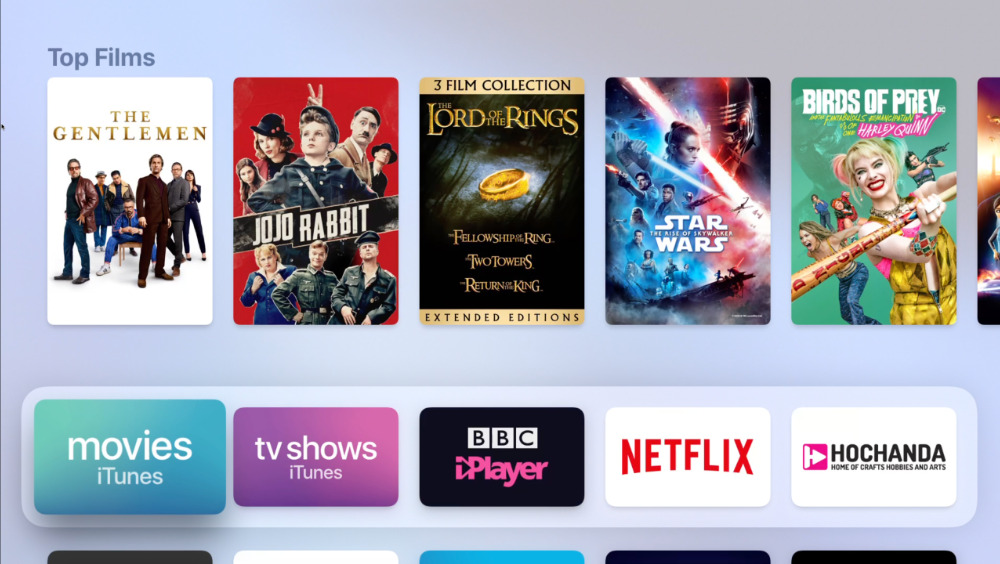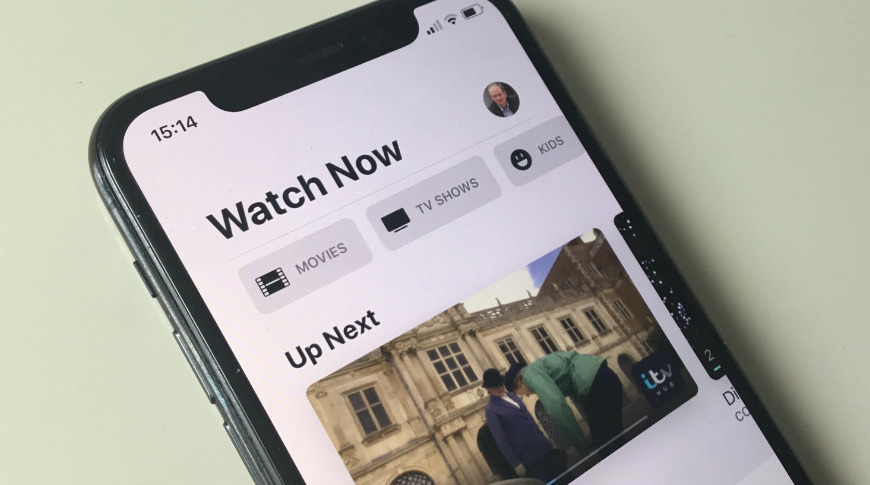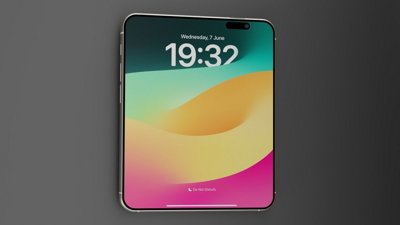If you instantly know the difference between Apple TV, Apple TV app, and Apple TV+, then remember there's also Apple TV Channels, Apple TV 4K, Apple TV HD, and the Apple TV apps for Apple TV, iPhone, iPad, Mac, and TV sets. What words are being overused here?
The reason that your Mac keyboard has a Command key with that clover-like icon is that designer Susan Kare put it there, but the reason she did is that Steve Jobs rejected the Mac team's original plan to put an Apple logo on it. Just as there's a Windows key for PCs, there would've been an Apple key for Macs, but Steve Jobs said no.
It appears that nobody else in Apple has ever said no since. Once the company took "Computer" out of its name, and once it stopped using "i" in front of everything, it settled on prefixing every product with the word Apple. Curiously, you can even date the move from "i" to "Apple" with the Apple TV as that had originally been announced under the name iTV.
At the time, changing it to Apple TV was just a legal decision after grumbles from the UK's television network ITV, but since then it's given rise to a generation. Not just of products named Apple, but specifically products named Apple TV.
Counting the different services, the different hardware, and the different apps, we make it that you can use the words "Apple TV" to mean about eight different things. We'd say that there may be a prize for anyone who can contort all eight into a single sentence, but we tried that above.
More seriously, we do regularly find ourselves having to explain how to get Apple TV+ through the Apple TV app on Apple TV. If only so that we can always refer you back to here, let us attempt to clear up the mess before Apple brings out yet another version of the Apple TV hardware.
Apple TV hardware
It all started in 2006 when Steve Jobs gave us a sneak peek of the iTV. We really wanted an actual TV set made by Apple. We did not know this was as close as we were going to get.
Flash forward to today and not a giant amount has really changed in the hardware. It's still what used to be referred to as a set-top box, and you plug it into your TV set.
Unless you have a Samsung smart TV or one from some other manufacturers that has Apple TV built in. Apart from those TV, Apple itself currently sells two versions of the Apple TV hardware.
There's the Apple TV 4K, and the previous model, now referred to as Apple TV HD to differentiate it. And that is the differentiation, really — one is a HD 1080p box, the other is a 4K one.
You can get them with different storage capacities, and there's a better processor in the 4K version. There's also better audio. But really, you're buying the $149 HD one to save a little bit of cash, or the $179 4K version because you have a 4K TV set.
Apple TV app
Whichever model you get, or if you watch through the right TV set, what you see first is the Apple TV home screen. And that is not the same thing as the Apple TV App — probably.
Originally, all Apple TV models started up with the home screen. Later, Apple introduced an app called Apple TV and loved it so much that they made it appear whenever you tried to go to the home screen.
Alas, there were problems. Apple presents that app as your one-stop place to watch everything available on your Apple TV — and it isn't. Netflix doesn't work with it. So you just have to leave that app to go watch the most popular streaming service in the world. And there are others.
 Apple TV is more expensive than its rivals, naturally, but for many people, this is how all their TV watching starts
Apple TV is more expensive than its rivals, naturally, but for many people, this is how all their TV watching startsThe way you get other services, such as Netflix, added to your Apple TV is to download their app from the Apple TV App Store. So when a channel tells you they're on Apple TV, that's what they mean — probably.
Apple TV Channels
Apple TV Channels were announced in March 2019 right alongside Apple TV+, but it's chiefly a new name for an existing idea. Apple TV has long boasted that you could watch 100 channels through it, and that includes live sports, plus subscription services like HBO Now.
Today, Apple TV Channels is one name for all the services you can watch through your Apple TV hardware, and specifically through the Apple TV app on it. Except for Apple's own.
In this sense, it's like Apple News. You get the regular Apple TV Channels service, and you can pay extra for Apple TV+. Except that what you get for your extra fee is solely Apple TV+, everything else remains either free or a separate subscription.
Then, too, Apple has still not rescinded its apparently temporary plan to give people one year's free Apple TV+ access when they buy a new device. So right now, for many people, Apple TV+ is an extra that's free.
Further muddying the waters enough to make this tricky to explain to your parents, is the business of what is a channel and what is an app. Whether you're Netflix with a library of on-demand programs, or you're ABC News with live broadcasts, it's up to you whether you choose to be a channel, an app, or conceivably both.
Apple TV+
This is now the highest-profile use of the words "Apple TV," and it is the ever-growing catalog of dramas, comedies, children's shows, documentaries, and films. It may not yet have become as ubiquitous as Netflix, and it doesn't appear to have grabbed the same instant high-profile that Disney+ has.
However, its slate of programs is wide, and so far every show is well made. Some are more successful than others, but as productions they are first-class and there is bound to be at least some you like.
There is just the question of where you watch them. It can be on a TV set, but it can also be in one last use of the Apple TV phrase.
Apple TV apps
On Apple TV itself, plus the iPhone, iPad, iPod touch, and Mac, there is an Apple TV app. You can't miss it because Apple doesn't call it Apple TV. Instead, it's just called TV.
Do a Spotlight search for the words "Apple TV" and your Mac or iOS device will know you really mean the TV app, and that's somehow a little indicative of the whole service. You want to do something and Apple TV translates that into what it thinks you want.
Except when it doesn't. You have to give Apple some credit for not swamping the TV app with its own Apple TV programs, but it doesn't have to make it quite so hard to find them.
This failing is not confined to Apple TV. Netflix is also difficult to dig through, but you'd hope that Apple would be better. Instead, Apple TV - sorry, the TV app — makes it very easy for you to continue watching something you've already started like a series.
It just takes a lot more steps to find, say, all the Apple TV+ comedies or films. That might be intentional now as the Apple TV library remains small, but the company is adding new shows all the time so the way you find them is becoming a bigger issue.
Nonetheless, those shows are there to be found. And if we rankle at saying the words "Apple TV" a dozen times per sentence, at least it is getting the title out there. There's no way to know if that ever translates into more people trying Apple TV+, but if it gets anyone taking a second look at the Apple TV apps, or the Apple TV set-top boxes, that's a good thing.
Keep up with AppleInsider by downloading the AppleInsider app for iOS, and follow us on YouTube, Twitter @appleinsider and Facebook for live, late-breaking coverage. You can also check out our official Instagram account for exclusive photos.
 William Gallagher
William Gallagher

-m.jpg)






 Amber Neely
Amber Neely
 Wesley Hilliard
Wesley Hilliard


 Christine McKee
Christine McKee


 Andrew Orr
Andrew Orr








24 Comments
A couple of days ago I posted on the Apple Discussion forum about this very issue. You wouldn’t believe how many people are confused about the free one year subscription to Apple TV+. There is a constant stream of posts from users asking why, every time they select a movie to watch, they are prompted to either rent or buy the title. They think the Apple TV+ subscription means they can watch everything free they find inside the Apple TV app. If it says Apple TV it means free and users associate it with streaming services like Netflix or Disney+. It’s causing great confusion and, more importantly, disappointment and anger at Apple’s offerings.
While there are some confusing branding issues going on here, probably the biggest underlying source of these problems is the jockeying for position of content providers. All the parts are there for cable providers, streaming services and individual channel apps to be fairly seamlessly integrated on the ATV box. The barriers to that are almost entirely due to individual content providers, e.g. Xfinity, Viacom, Netflix, etc., restricting or refusing to participate in those integrations. Netflix shows up within ATV’s search results, but won’t allow its content to be linked from within the ATV app. ATV has a single-sign-on feature for cable subscribers, but Xfinity won’t participate, which means their customers are frequently required to re-enter credentials for individual channel apps. Viacom has a feud with Comcast, so even though Xfinity customers get Viacom content via their cable box, they can’t have it on their ATV set-top box. There’s an Xfinity cable-box app for iPhones and iPads, but that’s not allowed on ATV, because everyone would return their $10/month cable box if there was. There’s too much money to be won or lost for these things to be allowed to work seamlessly. Apple may be the biggest company in the world, but they’re still not big enough to muscle the others into submission.
In some ways Apple is the most brilliant marketing company ever, but naming products they barely get passing marks - through the years they have been consistently inconsistent in naming products - I truly believe they’ve lost brand equity and revenue based on confusing their customers. It’s as if they do not have a master branding strategy, each new product launch feels is as if they have a new marketing team brainstorming without an understanding of the product branding past, present and future. Air, SE, i, plus, Apple, Pro, confusing except to the most loyal Mac fans like us readers that spend the time to learn it all and keep it straight. In some cases there is feature/function overlap which calls for research and comparisons to figure out what product best fits your needs, or the product has the same name as years prior with no numerical or year designator adding confusion to a more casual buyer (is it possibly deliberate?) — a mess in my opinion.
I may be old school, but a 10 page user guide for the Apple TV box, The TV app, and TV+ would help a heck of a lot of people. As for +, we have enjoyed Dickenson, Home, and are now starting on a few others.